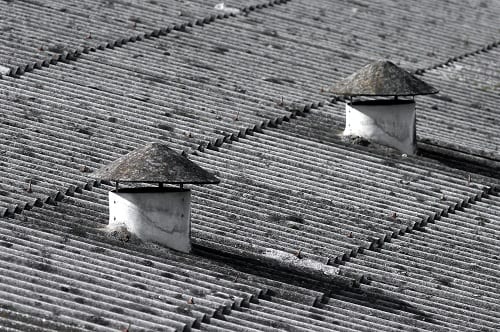Since 1993, the use of asbestos as a building material has been banned. Was your house built before 1 January 1994 and you want to remodel or demolish? Then you are obliged to have an asbestos inventory done. How does such an asbestos inventory work and what does it cost? Read all about asbestos inventory in this article.
What is asbestos inventory?
An asbestos inventory is an investigation into asbestos in a building or object. This involves identifying the asbestos-suspect materials present. All findings are then presented in an asbestos inventory report.
What does an asbestos inventory cost?
The cost of an asbestos inventory depends on the type of survey and the size of your property. An inventory is possible from as little as £300. See the cost chart below for the average cost of an asbestos inventory.
| Type of asbestos inventory | Average cost |
|---|---|
| Inventory visible material (formerly type A) |
£ 300 – £500 |
| Full inventory (former type B) |
From £450 |
Find the best specialist for your project and get free quotes.
Start
When to have an asbestos inventory done?
Asbestos is released when the material containing the asbestos is damaged. Inhaling the asbestos fibres is very harmful to your health, for example, it can cause asbestos cancer or lung cancer. It is therefore a legal requirement to carry out an asbestos inventory for buildings or objects built before 1 January 1994 when:
- You want to renovate or maintain the building;
- You want to demolish the building (partially);
- You want to have asbestos decontaminated;
- An incident has taken place.
If you are going to sell your property built before 1 January 1994, you are not obliged to have an inventory done. However, the buyer may consider it important and have it included in the deed of sale. Make mutual agreements about who is responsible for the inventory and the associated costs.
How does an asbestos inventory work?
To find out for sure whether your home contains asbestos before rebuilding, renovating or demolishing a building or object, have an asbestos inventory carried out. Asbestos inventories should only be carried out by companies certified to do so in order to carry out an asbestos inventory safely. The inventory contains several steps.
1. Desk research
First, the history of the building or object is mapped. They do this, for example, by examining documents such as architectural drawings, old building applications and other relevant data. Based on this, they can determine where potentially asbestos-suspicious materials will be present.
In addition, also tell the company what your plans are. Based on this, they can decide what kind of inspection should be carried out. After all, should you later discover that the inventory company needs to come back because the inventory was not complete enough for your purposes, it will cost you more. You can also have only part of your home inventoried, for example, if you only want to renovate the bathroom.
2. On-site inspection
The building inspection is carried out by a DIA: expert asbestos inventor. There are two types of inspection:
- Inventory visible material (formerly type A)
- Full inventory (formerly type B)
During the inspection, all rooms are systematically examined for asbestos-suspicious materials or objects. If any suspicious material is found, the specialist will take samples.
In the case of an inventory of visible material, only visible areas are checked. No (light) demolition work is carried out here. In the case of a full inventory, however, the specialist may (partially) demolish things like walls or ceilings to see what is behind them. They can then also carry out remedial work if necessary.
3. Report
After the inspection, the samples taken are analysed. All findings are then described in detail in the asbestos inventory report. You can use this report to apply for the necessary permits and to have asbestos removal carried out.
The asbestos inventory report contains, among other things, all information about the asbestos-containing materials that may have been found, the associated risks, advice on follow-up steps and an indication of the costs of any asbestos removal.

Asbestos found during the asbestos inventory, now what?
Asbestos comes in various colours. Two types of structure are also distinguished:
- Bonded asbestos
- Fixed asbestos
Bonded asbestos
Bonded asbestos usually does not need to be removed immediately. This is because the asbestos fibres are firmly stuck in the material. As long as the material is in good condition and is not being worked on, it poses no immediate danger. This is because the fibres only release when the material is damaged. An example of bonded asbestos is asbestos cement and corrugated asbestos sheets.
Asbestos Management Plan
Sometimes there is asbestos in a building, but it is not harmful to health. You do not then have to have the asbestos removed. Just make sure the situation is safe in the future. For this purpose, you have an asbestos management plan drawn up containing measures that guarantee the use of the building without risk.
If the asbestos inventory reveals that the asbestos poses a risk to your health, you must have the asbestos removed.
Loose-fixed asbestos
With loose-fixed asbestos, also known as non-fixed asbestos, the health risks are greater. This is because the fibres in this type of asbestos are not trapped in another material. These fibres are therefore more easily released into the air, making them more likely to be inhaled. Loose-bound asbestos must therefore be removed. One example is spray asbestos. Spray asbestos used to be regularly used as insulation material.

Frequently asked questions about asbestos inventory
1. Can there be asbestos present that was not found after the asbestos inventory?
This is certainly possible. An inventory around visible material (formerly Type A) only looks at directly observable asbestos and reasonable suspicion of asbestos in other locations. However, unforeseeable asbestos can be found anywhere, such as in demolition debris between ceilings. Do you think there is asbestos in your home, but it has not been clearly reflected in the asbestos inventory? If so, contact your asbestos specialist.
2. What documents do I need for an asbestos inventory?
To carry out an asbestos inventory, you do not need any special documents. However, it may help to give the building plans of your house to the asbestos specialist so that they know where the asbestos could possibly be.
3. No asbestos was found during my inventory, what now?
If no asbestos was found during your asbestos inventory, it is safe to start rebuilding, renovating or demolishing the building. Do pay attention to any building permits you may need. Therefore, always check with the municipality what steps you need to take before you start rebuilding.
4. Does asbestos have to be removed?
You do not have to remove asbestos, provided it does not pose a risk to your health or that of your neighbours. Is there asbestos in your premises but you are not having it removed? Then make sure you have an asbestos management plan to prevent health risks, such as asbestos cancer.
Find the best specialist for your project and get free quotes.
Start